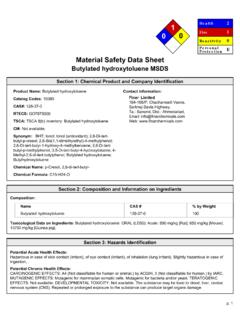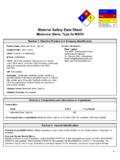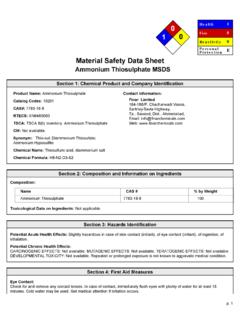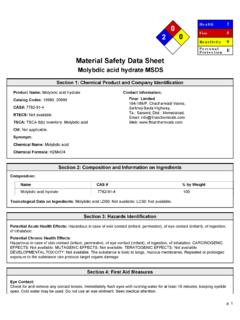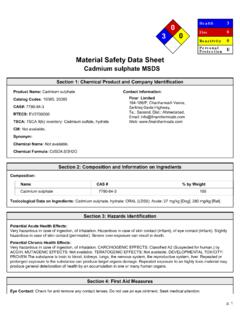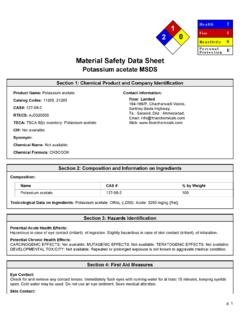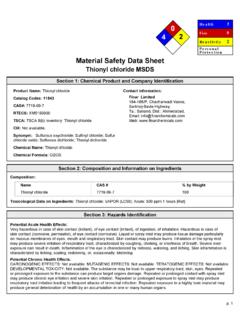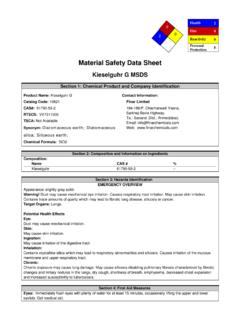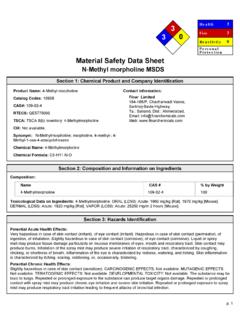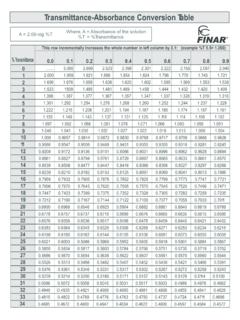Transcription of Material Safety Data Sheet - Finar Chemicals Ltd.
1 P. 1 1 3 0He a lt hFireRe a c t iv it yP e rs o n a lP ro t e c t io n310 HMaterial Safety data Sheet Aliquat 336 MSDSS ection 1: chemical Product and Company IdentificationProduct Name: Aliquat 336 Catalog Codes: 10053 CAS#: 5137-55-3 RTECS: BR8575000 TSCA: TSCA 8(b) inventory: TricaprylmethylammoniumchlorideCI#: Not : Tricaprylmethylammonium chloride chemical Formula: C25H54 ClNContact Information: Finar Limited184-186/P, Chacharwadi Vasna, Sarkhej-Bavla Highway, Ta.: Sanand, Dist.: Ahmedabad, Email: Web: 2: Composition and Information on IngredientsComposition:NameCAS #% by WeightAliquat 3365137-55-3100 Toxicological data on Ingredients: Aliquat 336: ORAL (LD50): Acute: 223 mg/kg [Rat]. 280 mg/kg[Mouse].Section 3: Hazards IdentificationPotential Acute Health Effects:Extremely hazardous in case of skin contact (irritant), of eye contact (irritant), of ingestion, of inhalation (lung irritant).
2 Hazardous in case of skin contact (corrosive, permeator). Inflammation of the eye is characterized by redness, watering, anditching. Skin inflammation is characterized by itching, scaling, reddening, or, occasionally, Chronic Health Effects:CARCINOGENIC EFFECTS: Not available. MUTAGENIC EFFECTS: Not available. TERATOGENIC EFFECTS: Not TOXICITY: Not available. Repeated or prolonged exposure is not known to aggravate medical 4: First Aid MeasuresEye Contact:p. 2 Check for and remove any contact lenses. Immediately flush eyes with running water for at least 15 minutes, keeping eyelidsopen. Cold water may be used. Do not use an eye ointment. Seek medical Contact:If the chemical got onto the clothed portion of the body, remove the contaminated clothes as quickly as possible, protectingyour own hands and body.
3 Place the victim under a deluge shower. If the chemical got on the victim's exposed skin, suchas the hands : Gently and thoroughly wash the contaminated skin with running water and non-abrasive soap. Be particularlycareful to clean folds, crevices, creases and groin. Cold water may be used. If irritation persists, seek medical attention. Washcontaminated clothing before Skin Contact:Wash with a disinfectant soap and cover the contaminated skin with an anti-bacterial cream. Seek immediate : Allow the victim to rest in a well ventilated area. Seek immediate medical Inhalation:Evacuate the victim to a safe area as soon as possible. Loosen tight clothing such as a collar, tie, belt or waistband. Ifbreathing is difficult, administer oxygen. If the victim is not breathing, perform mouth-to-mouth resuscitation.
4 Seek :Do not induce vomiting. Examine the lips and mouth to ascertain whether the tissues are damaged, a possible indication thatthe toxic Material was ingested; the absence of such signs, however, is not conclusive. Loosen tight clothing such as a collar,tie, belt or waistband. If the victim is not breathing, perform mouth-to-mouth resuscitation. Seek immediate medical Ingestion: Not 5: Fire and Explosion DataFlammability of the Product: May be combustible at high Temperature: Not Points: Not Limits: Not of Combustion: These products are carbon oxides (CO, CO2), halogenated Hazards in Presence of Various Substances: Not Hazards in Presence of Various Substances:Risks of explosion of the product in presence of mechanical impact: Not available. Risks of explosion of the product inpresence of static discharge: Not Fighting Media and Instructions:SMALL FIRE: Use DRY chemical powder.
5 LARGE FIRE: Use water spray, fog or foam. Do not use water Remarks on Fire Hazards: Not Remarks on Explosion Hazards: Not 6: Accidental Release MeasuresSmall Spill:Dilute with water and mop up, or absorb with an inert dry Material and place in an appropriate waste disposal Spill: Absorb with an inert Material and put the spilled Material in an appropriate waste 7: Handling and Storagep. 3 Precautions:Keep container dry. Keep away from heat. Keep away from sources of ignition. Empty containers pose a fire risk, evaporatethe residue under a fume hood. Ground all equipment containing Material . Do not ingest. Do not breathe gas/fumes/ vapour/spray. Never add water to this product In case of insufficient ventilation, wear suitable respiratory equipment If ingested, seekmedical advice immediately and show the container or the label.
6 Avoid contact with skin and eyesStorage:Keep container dry. Keep in a cool place. Ground all equipment containing Material . Keep container tightly closed. Keep in acool, well-ventilated place. Combustible materials should be stored away from extreme heat and away from strong 8: Exposure Controls/Personal ProtectionEngineering Controls:Provide exhaust ventilation or other engineering controls to keep the airborne concentrations of vapors below their respectivethreshold limit value. Ensure that eyewash stations and Safety showers are proximal to the work-station Protection:Splash goggles. Lab coat. Vapor respirator. Be sure to use an approved/certified respirator or equivalent. Protection in Case of a Large Spill:Splash goggles. Full suit. Vapor respirator. Boots. Gloves.
7 A self contained breathing apparatus should be used to avoidinhalation of the product. Suggested protective clothing might not be sufficient; consult a specialist BEFORE handling Limits: Not 9: Physical and chemical PropertiesPhysical state and appearance: : Not : Not Weight: g/moleColor: Not (1% soln/water): Not Point: 225 C (437 F)Melting Point: -20 C (-4 F)Critical Temperature: Not Gravity: (Water = 1)Vapor Pressure: Not Density: Not : Not Threshold: Not Dist. Coeff.: Not (in Water): Not Properties: See solubility in : Easily soluble in cold 4 Section 10: Stability and Reactivity DataStability: The product is Temperature: Not of Instability: Not with various substances: Not : Non-corrosive in presence of Remarks on Reactivity: Not Remarks on Corrosivity: Not : 11: Toxicological InformationRoutes of Entry: Dermal contact.
8 Eye contact. Inhalation. to Animals: Acute oral toxicity (LD50): 223 mg/kg [Rat].Chronic Effects on Humans: Not Toxic Effects on Humans:Extremely hazardous in case of skin contact (irritant), of ingestion, of inhalation (lung irritant). Hazardous in case of skincontact (corrosive, permeator).Special Remarks on Toxicity to Animals: Not Remarks on Chronic Effects on Humans: Not Remarks on other Toxic Effects on Humans: Not 12: Ecological InformationEcotoxicity: Not and COD: Not of Biodegradation:Possibly hazardous short term degradation products are not likely. However, long term degradation products may of the Products of Biodegradation: The products of degradation are more Remarks on the Products of Biodegradation: Not 13: Disposal ConsiderationsWaste Disposal:Section 14: Transport InformationDOT Classification: CLASS : Poisonous : : Toxic Liquid, (Tricaprylmethylammonium Chloride) : UN2810 PG: IIIS pecial Provisions for Transport: Not 5 Section 15: Other Regulatory InformationFederal and State Regulations: TSCA 8(b) inventory: Tricaprylmethylammonium chlorideOther Regulations:OSHA: Hazardous by definition of Hazard Communication Standard (29 CFR ).
9 EINECS: This product is on theEuropean Inventory of Existing Commercial chemical Classifications:WHMIS (Canada): CLASS D-1B: Material causing immediate and serious toxic effects (TOXIC).DSCL (EEC):R22- Harmful if swallowed. R37/38- Irritating to respiratory system and skin. R41- Risk of serious damage to ( ):Health Hazard: 3 Fire Hazard: 1 Reactivity: 0 Personal Protection: hNational Fire Protection Association ( ):Health: 3 Flammability: 1 Reactivity: 0 Specific hazard:Protective Equipment:Gloves. Lab coat. Vapor respirator. Be sure to use an approved/certified respirator or equivalent. Wear appropriate respiratorwhen ventilation is inadequate. Splash 16: Other InformationReferences: Not Special Considerations: Not : 10/06/2010 Last Updated: 24/11/2012 The information above is believed to be accurate and represents the best information currently available to us.
10 However, wemake no warranty of merchantability or any other warranty, express or implied, with respect to such information, and we assumeno liability resulting from its use. Users should make their own investigations to determine the suitability of the information fortheir particular purposes. In no event shall Finar Limited be liable for any claims, losses, or damages of any thirdparty or for lost profits or any special, indirect, incidental, consequential or exemplary damages, howsoever arising, even if Finar Limited has been advised of the possibility of such damages.
